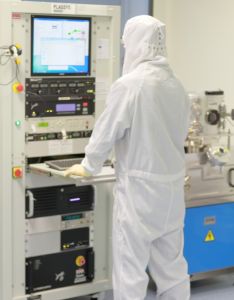
Over the past few months, so much of our work has been impacted by the COVID-19 pandemic--many of us are working from home, teaching online, and/or reaching out to our audiences in creative new ways. A number of our institutions are also working hard to support our communities beyond the classroom, perhaps by manufacturing personal protective equipment, supporting local testing efforts, and so much more.
While much could be said about the ongoing contributions of our community members both inside the classroom and out, this month’s From the Archive blog post is inspired by the global attention that nanotechnology-based approaches to diagnosing and treating COVID-19 have received. Highlighted below are an assortment of learning modules and lab activities that ATE grantees have created to support their work in teaching nanotechnology principles in the classroom.
Nano-Link’s DIY Collection
Nano-Link's twelve hands-on DIY modules provide highschool and college educators with an opportunity to integrate active learning lessons into their classrooms. Topics include aerogels, dye-sensitized solar cells, encapsulation and controlled release , light emitting diodes, memory metals, micelles , nano gold, nanocellulose, nanocrete, nanofiltration, nano treatment, and photolithography.
Each module includes a set of PowerPoint slides and an instructor guide that outlines learning outcomes, materials and equipment needs, a detailed description of the activity, discussion questions, and more. Some modules include a short video on activity set-up and delivery, while many offer a translated version of the module for Spanish language educators and learners. Activities vary in length, difficulty, and recommended education levels. All modules are available under the Creative Commons Attribution NonCommercial ShareAlike license.
For more archived resources by Nano-Link: Center for Nanotechnology Education, visit the ATE Central resource portal.
MEMS Foundational Learning Modules
The Support Center for Microsystems Education (SCME) offers an array of downloadable education materials on microelectromechanical systems (MEMS) and BioMEMS foundations, including learning modules on eight foundational topics. Each of the eight learning modules provide a host of materials, as illustrated by the two sample topics below:
- The MEMS History Learning Module provides "a timeline of the progression of microtechnology through a series of innovations that starts with the first Point Contact Transistor built in 1947 and ends with the optical network switch in 1999. Activities provide the opportunity to build on this timeline and to identify innovations of the 21st century that have contributed to current advancements in both micro and nanotechnology." This module includes six instructor guides, five participant guides, and a presentation.
- The Comparison of Scale Learning Module introduces "various concepts associated with scale, and a comparison of the macro, micro and nano-scales." This module is divided into the following six units: Knowledge Probe (KP) or Pre-test, Comparison of Scale Primary Knowledge (PK), Inquiry Activity: Cut-To-Size, The Scale of Biomolecules Activity, Scale Activity: Zoom In / Zoom Out, and Comparison of Scale Assessment. The module includes seven instructor guides, six participant guides, and a presentation.
For more archived resources by the Support Center for Microsystems Education (SCME), visit the ATE Central resource portal.
SHINE Lab Experiments
Created by Seattle's Hub for Industry-driven Nanotechnology Education (SHINE), this series of lab experiments is designed to introduce students to nanotechnology principles. The series covers basic principles, lithography, synthesis of nanoparticles, nanocrystalline solar cells, and water splitting. Two labs are described in more detail below:
- Nanotechnology Principles Lab: Lithography includes one lithography presentation, three labs, a lithography background document, and material safety data sheets. The Lithography PowerPoint presentation covers topics such as photolithography, soft lithography, negative photoresist, microfluidics, lab on a chip applications, parallel analysis, laminar flow, microfluidic videos, and more.
- Nanotechnology Principles Lab: Synthesis of Nanoparticles includes a Nanoparticle Synthesis and Applications PowerPoint presentation, three lab activities, and data safety sheets. The Nanoparticle Synthesis and Applications presentation covers topics such as silver nanoparticles, silver nanoparticle products, ethics, the color of gold, salt censors, gold nanoparticles, other gold nanoparticle uses, and more.
For more archived resources by Seattle's Hub for Industry-driven Nanotechnology Education (SHINE), visit the ATE Central resource portal.

 Subscribe
Subscribe


 See More ATE Impacts
See More ATE Impacts

Comments
There are no comments yet for this entry. Please Log In to post one.